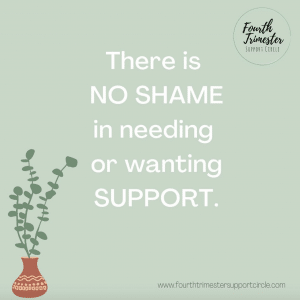
Nov 3, 2021 | Uncategorized
Your baby bump is growing. How exciting! You’re finally showing off that adorable bump, but you’re starting to notice that a bigger bump comes with more aches and pains, especially in your back. Don’t despair – I’m going to share the one surprising thing that completely helped me and can improve your pregnancy back pain.
Why Does Your Back Hurt So Much?
Our growing babies are stretching the muscles around our bellies, pulling our round ligaments in our groins and around our backs. The more our bumps grow, the more weight and pulling of our muscles. Plus, your baby may be laying more on your spine. Perhaps your baby is in the posterior position, aka sunny side up, and putting even more of its weight on your back. All of this is going to cause achiness and pain.
But, this doesn’t mean you need to suffer needlessly. So, how can you improve your pregnancy back pain?
______________________________________________________________________________
 Relieve Your Miserable Pregnancy Symptoms in 5 Days
Relieve Your Miserable Pregnancy Symptoms in 5 Days
Free virtual retreat Nov 13-17
Live your best baby bump life and get rid of those pregnancy symptoms that are making you feel miserable. Fatigue, morning sickness, pelvic pain, and more!
________________________________________________________________________________
The One Trick That Helped Me
This one thing will not cost you any money. I had bought a pregnancy belly band to help with my round ligament pain, and it did provide some relief while I was at work, but it didn’t help with my back pain.
 My chiropractor, Lisa Lipari, suggested I try pelvic tilts to ease my back pain. What are pelvic tilts? If you do yoga, you may know them as the Cat/Cow pose. And it made a huge difference in my pregnancy.
My chiropractor, Lisa Lipari, suggested I try pelvic tilts to ease my back pain. What are pelvic tilts? If you do yoga, you may know them as the Cat/Cow pose. And it made a huge difference in my pregnancy.
This movement requires you to be on all fours and tilt your pelvis downward toward the floor and back up, almost forming a straight table with your spine. Don’t tilt your pelvis all the way up to the ceiling like you would in yoga.
I did this move several times a day, but especially right before bed. I couldn’t sleep because my back was so uncomfortable, but once I started doing 20 sets of these beforehand, my pain was at ease and I could sleep! Try doing the same before bed every night.
BONUS – this move is wonderful for improving your pelvic floor and having a smoother labor!
*As always, ask your doctor if you’re cleared for exercise before attempting this stretch*

Sep 22, 2021 | Uncategorized
You’re pregnant! Hooray! And even better, you’ve gotten through the first trimester’s dreaded morning sickness period. Hopefully by now, your stomach is taking it easier on you and you’re starting to eat more normally, or even getting some cravings. Either way, I know you’ve heard the phrase “Eating for two.” It’s often misinterpreted as the ability to each twice as much during pregnancy. Don’t get me wrong – you DO need more calories every day through pregnancy. Roughly 300-500 calories per day depending on your pregnancy weight management. What I don’t like about this term is when it is stereotypically used, or as a joke because of pregnancy weight gain.
There can be a lot of feelings of guilt and shame for moms-to-be, especially plus size mamas. Whatever your body shape, I don’t want you to ever feel bad for eating. You need to eat for your well-being. So, let’s change the meaning behind “eating for two.”
What Eating for Two Means to Me
The phrase traditionally refers to the portion size aka amount of food. To me, eating for two means nourishing yourself and your baby. But, not in the manner of eating double the portions. Instead, you’re eating the nutrients and delicious meals you need to effectively create the building blocks of your baby’s life and support your own well-being. What you eat is also what your baby’s eating. I want you both to have the best of what you need. Quality over quantity.
Are you stress eating? Take my pregnancy stress quiz to uncover your stress levels and get a personalized plan for addressing stress.
Look, you don’t have to constantly eat a salad. That’s not what I’m saying here. It’s totally okay to enjoy that slice of pizza or some ice cream. You don’t need to deny yourself pleasures as long as they fit within the parameters of your pregnancy and your care provider hasn’t restricted your diet. But, the goal before occasionally indulging is to get the other foods you need for a healthier and more comfortable pregnancy.
 What Do You Need to Eat for a Healthy Pregnancy?
What Do You Need to Eat for a Healthy Pregnancy?
Let’s break it down. First and foremost, you need protein, and there are lots of ways to get it even if you’re a vegetarian or are vegan. You need healthy, complex carbs from whole grains and multigrains. Simple carbs like white bread and those in a lot of products in the snack aisle are going to break down into extra sugar, while complex carbs will provide some protein, fiber, iron, and more! You need healthy fats, omega-3s and omega-6s, as well as more fiber (for that pregnancy constipation).
When you can get all these essential nutrients into your diet, you and your baby will feel nourished and supported.
Learn more about having a healthy pregnancy here.

Sep 3, 2020 | Postpartum, Uncategorized
Finding My Postpartum Village
I didn’t understand how true the saying “It takes a village” really is and how badly I needed that village in postpartum. While as a birth educator I know preparing for labor and birth is very important, I didn’t spend nearly as much time preparing for what comes after. Sure, I got the breast pump, nursing pads, mesh underwear, perineal spray, etc. All of those items were helpful. But what I needed, what I really needed, I couldn’t buy on Amazon.
Support. A community of other new moms going through the same challenges, joys, feelings I was going through. This is what I was missing. Although I had my close friends and family, I still felt a bit isolated because no one else was experiencing postpartum with me. In a way I was alone and at the time I didn’t realize that I didn’t have to feel like that. I was stubborn to opening up and asking for more help.
Postpartum Requires Support
 At around four months postpartum, I received an invitation to the Fourth Trimester Support Group at The Nesting Place from part owner and colleague Laura Siddons. She asked if I’d like to sample the group to see what it’s all about not just for future postpartum clients, but also for myself as a new mom. The group was around 45 from me and I was suffering a lot of anxiety while driving. I let my anxiety get in the way of going for a while, but eventually I did make it to a group meeting and what I found was an amazing group of friendly, supportive moms, a generous host, and a knowledgeable guest expert. In that meeting alone, I learned baby massage techniques that helped greatly soothe my baby before bed and made life much easier for me.
At around four months postpartum, I received an invitation to the Fourth Trimester Support Group at The Nesting Place from part owner and colleague Laura Siddons. She asked if I’d like to sample the group to see what it’s all about not just for future postpartum clients, but also for myself as a new mom. The group was around 45 from me and I was suffering a lot of anxiety while driving. I let my anxiety get in the way of going for a while, but eventually I did make it to a group meeting and what I found was an amazing group of friendly, supportive moms, a generous host, and a knowledgeable guest expert. In that meeting alone, I learned baby massage techniques that helped greatly soothe my baby before bed and made life much easier for me.
Since I visited the group, I’ve been able to cultivate my own supportive village out of friends, colleagues, and new moms. I know who I can message at any time during the day when I have a question about my growing baby (now toddler), parenting tips, or when I just need to vent.
I’m so glad I found support. I am a stubborn person who has trouble asking for help, but my experience helped bring down those walls, allow me to get what I need, and learn how to give others that postpartum support freely with compassion and love.
Find Your Support
I’m so excited to now be facilitating a Fourth Trimester Support Group starting September 16. Reserve your spot and start your journey of finding your motherhood village.
With love,
Cass

Nov 20, 2019 | Birth, Uncategorized
It’s no secret the TV and movie industry likes to take liberties when it comes to accurately portraying events. But, its representation of birth is perhaps the most dramatic and is negatively affecting our perception of labor and delivery. The differences between a Hollywood and real life birth may surprise you. Below is my list of the worst birth myths that Hollywood perpetuates.
Laboring on Your Back

This is perhaps the most egregious birth myth out there. Known as the supine position in the birth world, lying on your back is the least effective position in which to labor. It is horribly uncomfortable, putting unnecessary pressure on your back during contractions, and doesn’t help move the birth process along. The only reason this portrayal has become commonplace is the popularity of the epidural, which requires people in labor to stay in bed because it causes numbness in the waist down (if it works correctly). Best evidence research proves that birth outcomes improve by laboring while walking and in standing and squatting positions. You are also more likely to tear when delivering baby on your back.
I’m not discouraging or encouraging an epidural. Lots of people get them, including myself after hours of excruciating back labor. All I’m saying is lying on your back before possibly receiving an epidural or while laboring naturally should not be commonplace as shown in the media we consume.
*If you’re thinking of getting an epidural, but don’t want to deliver on your back, ask your care provider about the possibility of giving birth on all fours in the hospital bed. Often the epidural will be turned down so you can feel the need to push after reaching 10cm. If your care provider says it’s hospital policy that you can only deliver on your back when receiving an epidural, talk to your childbirth educator and/or doula about it. They can provide you with research and evidence to speak about with your doctor.
**If you’re ever not happy with your care provider, you can switch to someone else!
Screaming Bloody Murder

Contractions are intense, don’t get me wrong, but you’re not going to hear screams coming from every room in the maternity ward. Most people try to breathe through them and give out a low, guttural moan, which is actually a very positive and helpful action during labor. Deep tone moans help to release tension, keeping the jaw loose and the perineum.
Surprise, surprise that the things women have been doing naturally during birth throughout history have an important purpose! Our bodies are amazing. We need to trust our instincts rather than what our media tries to sell us about childbirth.
My Water Just Broke!

Hollywood loves this one – the pregnant woman who has been experiencing little to no contractions all of a sudden has a gush of water spray from between her legs. Cut to a look of shock on the characters’ faces as the woman yells, “My water just broke!” Then they rush to the hospital. Life seldom imitates this art.
While, yes, some women do experience a gush of water when their amniotic sac breaks, it’s more common for women to feel a trickle of water down their legs. This all depends on where the amniotic sac breaks. If the protective barrier separates in the back or sides, then it takes longer for the fluid to get out, hence the trickle. Your bag of waters may not break at all until you start the pushing stage.
There’s also no reason to rush to the hospital if your water breaks beforehand, unless it smells funky and has a green tint. This could mean baby has passed meconium in the amniotic sac and your care provider will most likely want you to come in. Call your midwife or doctor if this happens.
*Remember, if you’re labor is low risk and you’re having a vaginal delivery there’s rarely a good medical reason for your care provider to break your bag of waters. It increases the risk of infection and there’s no harm in letting it break naturally on its own.
Hope you enjoyed reading about these birth myths! Learn more about childbirth with my Informed & Mindful Birthing online class.

 Relieve Your Miserable Pregnancy Symptoms in 5 Days
Relieve Your Miserable Pregnancy Symptoms in 5 Days My chiropractor, Lisa Lipari, suggested I try pelvic tilts to ease my back pain. What are pelvic tilts? If you do yoga, you may know them as the Cat/Cow pose. And it made a huge difference in my pregnancy.
My chiropractor, Lisa Lipari, suggested I try pelvic tilts to ease my back pain. What are pelvic tilts? If you do yoga, you may know them as the Cat/Cow pose. And it made a huge difference in my pregnancy.


 What Do You Need to Eat for a Healthy Pregnancy?
What Do You Need to Eat for a Healthy Pregnancy?
 At around four months postpartum, I received an invitation to the
At around four months postpartum, I received an invitation to the 



Recent Comments